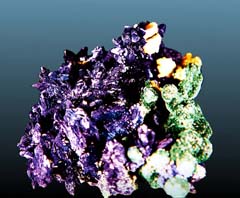About the chemical structure:
| Chemical name: | arsenic sulfide |
| Formula: | As4S4 |
| Crystal system: | Monoclinic - Prismatic (at Mineralogy Database) |
| Refractive index: | alpha =1.73, beta =1.758, gamma =1.838 |
Color:
| Color Index (C.I.) | PB 30 |
How can you identify Realgar?
Imaging:
UVF: no
FCIR: dark blue
OM: particles are anisotropic and exhibit high birefringence. Crystals exhibit pleochroism, turning from blue crystals with yellow edges to navy crystals with bright blue centers. Particles show occasional complete oblique distinction and exhibit blue/green-blue pleochroism. Transmission colours with the Chelsea filter = deep blue and grey/blue.

Microscopic appearance at x500 mag
Analytics:
Azurite can be identified by means of Raman, UV/VIS/IR and FTIR spectroscopies. XRF spectroscopy permits to easily detect the copper.
Raman spectra: University College London;
FTIR spectra: IRUG;
UV/VIS/IR spectra: SpecLib, NASA, US Geological Survey
Usage and handling:
| Permanence: | Toxicity: |
|---|---|
Lightfast: good Degradation processes: the intensity of the blue is due to the presence of copper and the way it is chemically bound to the hydroxyl (OH) and carbonate (CO3) groups. Azurite has good permanence in oil and tempera media, although it is subjected to two process of degradation into green or into black. Indeed, malachite, another naturally occurring copper mineral, is just a more oxidized form of the mineral azurite. Hence it is the increased oxidation that causes the colour change from blue to green. The formula for the change includes the addition of a water molecule to that of two azurite molecule which releases one of carbon dioxide and leaves three malachite molecules. Oxidation is ongoing hence the slow transformation from blue to green. Azurite suffer also the alteration in a black pigment, the copper oxide, tenorite.
Example of dark blue azurite crystals and green aggregates of malachite on the same rock. |
moderately toxic. Care should be used in handling the dry powder pigment as well as the pigment dispersed in medium. MSDS: Natural Pigments |
Literature:
Artists’ Pigments. A Handbook of Their History and Characteristics, Vol. 2: A. Roy (Ed.) Oxford University Press 1993, p. 23-35
(intro) - Azurite - Cerulean Blue - Cobalt blue - Egyptian blue - Prussian blue - Smalt - Ultramarine


